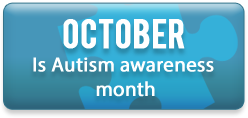Autism is a complex developmental disorder that typically affects a person’s ability to communicate, form relationships, and respond appropriately to the environment. Autism results from a neurological disorder that impedes normal brain development in the areas of social interaction, behaviour and communication skills.
Autism is a neurological condition the cause(s) of which are not yet fully understood. Genetic factors may be involved in some cases. Medical research is beginning to find some clues about underlying medical or metabolic conditions.
Autism knows no racial, ethnic, social, or economic boundaries, and the overall incidence rate is relatively consistent around the globe. There is no definitive cause or cure for this lifelong disorder, which affects four times as many boys as girls and usually manifests itself during the first three years of life. Also according to the Center of Disease Control the incidence of autism is now 1 in every 59 births. Autism is more common than Down syndrome, childhood cancer and juvenile diabetes.
Often referred to as a “spectrum disorder,” the symptoms and characteristics of autism can present themselves in a variety of combinations, to varying degrees of severity, from mild to severe. The phrase “autism spectrum disorders” (ASD) refers to a broad definition of autism including Pervasive Developmental Disorder (PDD), Rett’s syndrome, Asperger syndrome, and Childhood Disintegrative Disorder.
People with autism process and respond to information in unique ways. Common traits of autism include:
- Resistance to change
- Odd repetitive motions
- Preference for being alone
- Aversion to cuddling
- Avoidance of eye contact
- Inappropriate attachments to objects
- Hyper-activity or under-activity
- Over- or under-active sensory responsiveness
- Uneven gross/fine motor skills, such as difficulty grasping objects, or dressing themselves
- Repeating words or monologues
- Laughing, crying, or showing distress for unapparent reasons
- Unresponsive to verbal cues
- Tantrums, and possible aggressive and/or self-injurious behaviors
Like all individuals, however, those with autism have unique personalities and combinations of autistic characteristics. Many children and adults with autism have or develop the ability to make eye contact, show affection, smile, laugh, and build verbal or non-verbal language skills, but generally in different ways than typically-developing individuals. Since autism was first described more than 60 years ago, the body of related knowledge has grown substantially. However, a vast majority of the public, including many medical and educational professionals, is still unaware of how autism affects people and how to effectively support and interact with affected individuals. 48% of children diagnosed can become indistinguishable among their peers with early intensive intervention using behavioral principles and structured teaching.




